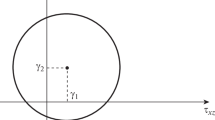Abstract
A coordinate transformation is used to take the domain of the rod cross-section to a rectangular domain for which the spectra of eigenfunctions and eigenvalues are known. The torsion function is represented as a generalized Fourier series to reduce the problem to solving a closed linear system of algebraic equations for the expansion coefficients. It is shown that these Fourier series converge absolutely, because the expansion coefficients decrease by a cubic law depending on the term number. We prove that the approximate solution in the form of a finite sum of the Fourier series converges to the exact solution. This theorem is generalized to the case of a rod cross-section of arbitrary shape.
Similar content being viewed by others
References
A. I. Lurie, The Theory of Elasticity (Nauka, Moscow, 1970) [in Russian].
S. P. Timoshenko and J. N. Goodyear, Theory of Elasticity (McGraw-Hill, New York, 1951; Nauka, Moscow, 1975).
N. I. Muskhelishvili, Several Fundamental Problems of Mathematical Theory of Elasticity (Izd-vo AN SSSR, Moscow, 1954) [in Russian].
N. Kh. Arutyunyan and B. L. Abramyan, Torsion of Elastic Bodies (Fizmatgiz, Moscow, 1963) [in Russian].
V. A. Lomakin, “Torsion of Rods with Elastic Properties Depending on the Stress State Form,” Izv. Akad. Nauk.Mekh. Tverd. Tela, No. 4, 30–39 (2002) [Mech. Solids (Engl. Transl.) 37 (4), 23–30 (2002)].
A. V. Konovalov, “Torsion of Cylindrical Rods and Pipes with Large Plastic Strains,” with Large Plastic Strains,” Izv. Akad. Nauk. Mekh. Tverd. Tela, No. 3, 102–111 (2001) [Mech. Solids (Engl. Transl.) 36 (3), 86–94 (2001)].
L.M. Zubov, “The Non-Linear Saint-Venant Problem of the Torsion, Stretching and Bending of a Naturally Twisted Rod,” Prikl. Mat. Mekh. 70(2), 332–343 (2006) [J. Appl. Math. Mech. (Engl. Transl.) 70 (2), 300–310 (2006)].
G. I. Bykovtsev and D. D. Ivlev, Theory of Plasticity (Dal’nauka, Vladivostok, 1998) [in Russian].
V. A. Il’in, Spectral Theory of Differential Operators. Self-Adjoint Differential Operators (Nauka, Moscow, 1991) [in Russian].
E. M. Kartashov, Analytical Methods in Heat Conductivity of Solids (Vysshaya Shkola, Moscow, 2001) [in Russian].
A. D. Chernyshov, “Solving Nonlinear Boundary Value Problems by the Spectral Decomposition Method,” Dokl. Ross. Akad. Nauk 411(6), 775–778 (2006) [Dokl. Phys. (Engl. Transl.) 51 (12), 697–700 (2006)].
G. P. Tolstov, Fourier Series (Dover, New York, 1976; Nauka, Moscow, 1980).
A. N. Kolmogorov and S. V. Fomin, Elements of the Theory of Functions and Functional Analysis (Nauka, Moscow, 1981; Dover, New York, 1999).
Author information
Authors and Affiliations
Corresponding author
Additional information
Original Russian Text © A.D. Chernyshov, 2014, published in Izvestiya Akademii Nauk. Mekhanika Tverdogo Tela, 2014, No. 2, pp. 132–144.
About this article
Cite this article
Chernyshov, A.D. Torsion of an elastic rod whose cross-section is a parallelogram, trapezoid, or triangle, or has an arbitrary shape by the method of transformation to a rectangular domain. Mech. Solids 49, 225–236 (2014). https://doi.org/10.3103/S0025654414020125
Received:
Published:
Issue Date:
DOI: https://doi.org/10.3103/S0025654414020125




